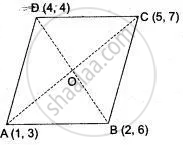Advertisements
Advertisements
प्रश्न
Show that the points A(1, 3), B(2, 6), C(5, 7) and D(4, 4) are the vertices of a rhombus.
= `a(1/t^2 + 1) = (a(t^2 + 1))/t^2`
Now `(1)/"SP" + (1)/"SQ" = (1)/(a(t^2 + 1)) + (1 xx t^2)/(a(t^2 + 1)`
= `((1 + t^2))/(a(t^2 + 1)`
`(1)/"SP" + (1)/"SQ" = (1)/a`.
उत्तर
To show that ABCD is a rhombus, it is sufficient to show that
(i) ABCD is a parallelogram i.e., AC and BD have the same mid point.
(ii) A pair of adjacent sides are equal.
Now, ,midpoint of AC = `((1 + 5)/2, (3 + 7)/2)`
= (3, 5).
Midpoint of BD = `((4 + 2)/2, (4 + 6)/2)`
= (3, 5).
Thus, ABCD is a parallelogram.
Also AB2 = (2 - 1)2 + (6 - 3)2
= 1 + 9 = 10 units.
BC2 = (5 - 2)2 + (7 - 6)2
= 9 + 1 = 10 units.
Therefore AB2 = BC2 ⇒ AB = BC
Hence, ABCD is a rhombus.
APPEARS IN
संबंधित प्रश्न
P(1, -2) is a point on the line segment A(3, -6) and B(x, y) such that AP : PB is equal to 2 : 3. Find the coordinates of B.
In what ratio does the point (1, a) divide the join of (–1, 4) and (4, –1)? Also, find the value of a.
If the abscissa of a point P is 2, find the ratio in which this point divides the line segment joining the point (−4, 3) and (6, 3). Also, find the co-ordinates of point P.
A(–4, 2), B(0, 2) and C(–2, –4) are vertices of a triangle ABC. P, Q and R are mid-points of sides BC, CA and AB respectively. Show that the centroid of ΔPQR is the same as the centroid of ΔABC.
Find the image of the point A(5,3) under reflection in the point P(-1,3).
Find the image of the point A(5,3) under reflection in the point P(-1,3).
Determine the ratio in which the line 3x + y – 9 = 0 divides the line joining (1, 3) and (2, 7).
The midpoint of the line segment AB shown in the diagram is (4, – 3). Write down the coordinates of A and B.
Determine the centre of the circle on which the points (1, 7), (7 – 1), and (8, 6) lie. What is the radius of the circle?
From the adjacent figure:
(i) Write the coordinates of the points A, B, and
(ii) Write the slope of the line AB.
(iii) Line through C, drawn parallel to AB, intersects Y-axis at D. Calculate the co-ordinates of D.
